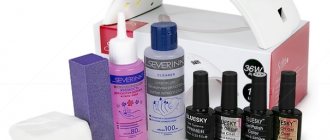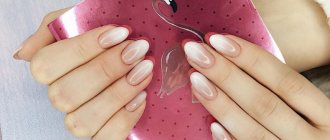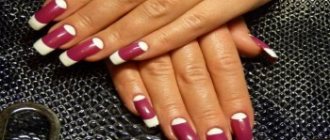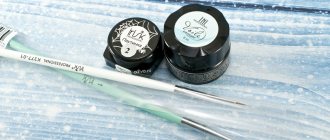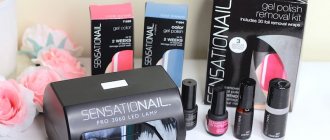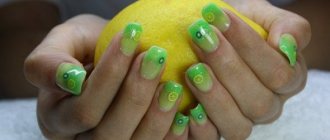- 14751
- 08-01-2019
- Author: Mysekret Team
- 0
Nail extension is the modeling of natural nails in order to correct existing defects. Extension also means artificially increasing the length of nails.
What's included in the nail extension kit?
For beginners, and even some professional craftsmen, it is sometimes more convenient to buy a ready-made set of materials than to type everything separately. The filling may vary and this is one of the most important parameters affecting the cost. What is included in the kit depends on the type of extension the artist plans to perform: gel or acrylic. There are also universal kits. Some also include design accessories.
Professional kit
The kits for specialists contain high quality materials. The filling depends on the type of extension that is planned to be performed. If a master is going to model acrylic nails, then you need to pay attention to kits with the following assortment:
- tips (a backing for artificial material to form a free edge of a certain length);
- cuticle oil;
- guillotine for cutting tips;
- base coat;
- forms;
- acrylic powder (several types, usually transparent, white, camouflage);
- natural bristle brush;
- liquid (liquid mixed with acrylic powder to form an artificial nail plate);
- glue;
- remover without acetone (liquid for removing artificial material);
- orange sticks;
- primer (a product that degreases the natural nail plate);
- antiseptic;
- mixing containers;
- files with abrasiveness 100/100, 180/180 and 180/240 grit;
- brush for removing dust from the surface of the nail.
The configuration of the collection for working with gel is significantly different. This includes the following materials and tools:
- tips;
- multifunctional product that works as a dehydrator, antiseptic, and liquid for removing layers;
- forms;
- top coat with UV filter;
- glue;
- cuticle oil (softens the skin, making it easier to remove with chopsticks);
- tip cutter (to adjust the length of the artificial substrate);
- orange sticks (for pushing back cuticles and removing stray lint);
- solution for removing the sticky layer;
- cream;
- primer (degreases the nail plate and provides it with good adhesion to the artificial material);
- scissors;
- dust removal brush;
- files with abrasiveness 100/100, 180/180, 180/240 grit;
- electric ultraviolet lamp (for home use, you need a device with a power of approximately 36 W with a timer);
- synthetic brush (flat, square or rectangular);
- buff 120/120/120 grit (a block with rough surfaces for final leveling and grinding);
- rhinestones, glitter and bouillons of several shades, other decorative accessories;
- gels.
It is worth saying more about the main material for extensions. The composition may include the following gels:
- basic (applied in a thin layer, serves as a base);
- sculpting (applied in several layers);
- single-phase;
- for finishing;
- colored.
Starter kit for nail extensions
Filling kits for beginners is a little easier. In the starter collection you can find materials of average quality, but its price will be affordable. This is the best option for artists who want to practice extensions. Standard basic sets may also differ from professional ones in that they contain neutral and most popular shades of acrylic and gel, for example, transparent, pink-beige, white. What may be included in the starter kit:
- materials for extension and correction (gels or acrylic powder and monomer);
- files of different shapes and degrees of abrasiveness;
- tips;
- cuticle care product;
- forms;
- lint-free wipes;
- UV lamp;
- primer;
- orange sticks;
- glue;
- a natural bristle brush for modeling acrylic nails or a synthetic brush for working with gel;
- wire cutters;
- buffs to eliminate roughness.
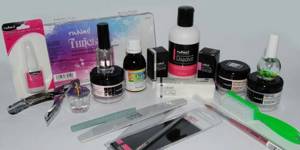
Tips and tricks for selection and use
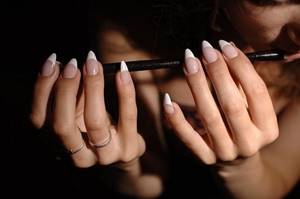
- The quality of materials depends on the manufacturer. Therefore, you should not purchase materials from dubious companies.
- Since nail files often have to be replaced, it is recommended to buy several at once.
- A few days before the extension, it is recommended to remove the cuticle and file the nails.
- Immediately before extensions, you should not use hand care cosmetics (cream, oil, etc.).
- Materials used for extensions should be kept away from direct sun.
- The surface of the nail should be washed down very carefully and very little. This is necessary for better contact of the gel with the surface to which it is applied.
- When using tips, they are selected and prepared for each finger in advance.
- If you regularly engage in active extensions, then the ready-made starter kit will have to be completed.
- To purchase all the components separately, you need to understand them well and know exactly what you can’t do without.
- Brushes for modeling come from No. 6 to No. 12, and for drawing - from No. 1 to No. 6. Before first use, the brush should be rinsed and dried.
- Beginners are advised to get their hands on simple designs before taking on complex ones. To perform nail art with drawings, stucco moldings, etc., you will need additional devices and accessories.
Pros and cons of purchased collections
People considering whether to purchase a resource kit should be aware of its positive and negative aspects. Advantages of the collections:
- The kit will be cheaper than buying all the products separately.
- Purchasing the kit online will save you time.
- As a rule, the materials and tools included in the kit are correctly matched to each other, so they are easy to work with.
- The collection includes everything you need so that even a beginner can easily complete a full extension.
The kits are not without certain disadvantages. Their main disadvantages:
- Not all products from the same manufacturer are equally good. For example, one company may produce excellent acrylics, but low-quality files.
- Professional craftsmen will have to complete the set or replace individual components in accordance with their preferences.
- The kit includes products of a certain volume; you cannot choose one or another quantity.
How to choose a kit for nail extensions at home
It is difficult for almost any person, especially a beginner, to decide which kit to purchase, although the breadth of the range offered on the market is impressive. If you want to buy a nail extension kit, use the following tips:
- The quality of materials is directly affected by the manufacturer. It is not recommended to buy products from little-known brands, even if they offer a temptingly low price. Check out online reviews of different manufacturers. The opinions of craftsmen who have already worked with certain materials will help you make the right decision. The company must provide quality certificates for its products.
- It is advisable to immediately buy a collection that includes at least a minimum number of design accessories.
- There should be a lot of nail files in the kit, because they wear out faster than anything else. It is important that they have varying degrees of abrasiveness.
- If you plan to regularly do nail extensions, make sure that the set can be expanded. It is preferable to buy consumables from the same manufacturer in the future.
Distinctive features of gel and acrylic
The problem of choosing one of these materials is relevant for both craftsmen and clients. As a rule, women try both gel and acrylic nails, and then determine which they like best. With masters the picture is not too different. Some work only with acrylic, others exclusively with gel, but most specialists master both types of extensions in order to provide clients with the widest possible range of services. The durability of nails and their appearance depend not so much on the material as on the professionalism of the artist. The properties of the natural plate play a role.
Acrylic nails are obtained by mixing powder and monomer. When they react, these substances turn into a thick mass, which gradually hardens completely at room temperature. Features of acrylic:
- The material is easier to remove from the natural nail plate than gel. A special liquid without acetone is required.
- For the extension process, only a brush with natural bristles is used. First, it is dipped into the monomer, then dipped into the powder for a couple of seconds. The resulting ball is transferred to the nail with a backing (tip or stencil) and an artificial plate is formed. This is where difficulties arise. Firstly, you need to work with acrylic quickly, and secondly, it is difficult to guess the correct ratio of monomer and powder to obtain the desired consistency of the ball. These problems go away with experience.
- Acrylic nails are slightly thicker than gel nails, but they are not as brittle.
- No UV lamp is required to dry the material.
- The acrylic extension procedure takes less time than gel extension.
- Apple cider vinegar benefits and harms for the human body
- How and with what to treat gardnerella in women
- Chicken satsivi - step-by-step recipes with photos. How to cook chicken in nut sauce in Georgian style
The second material, unlike acrylic, is immediately ready for use and does not need to be mixed. Gel is a viscous and sticky substance with a consistency ranging from semi-liquid to jelly-like. Hardens under the influence of ultraviolet radiation. Peculiarities:
- The polymer gel plate is thinner than the acrylic one, and its strength is lower.
- Each new layer of coating must be dried in an ultraviolet lamp for a certain amount of time, otherwise it will remain liquid. The gel reaches a solid consistency only under the influence of UV rays.
- The coating shines very beautifully even without sanding or polishing.
- Modern gels are self-leveling. They immediately form a homogeneous, flat surface that does not need to be filed or sanded.
- The material does not emit an unpleasant odor.
- There is no need to rush when working with gel. You can do everything slowly and carefully, achieving the desired result. The material will still not harden until it hits the lamp.

Which is better - tips or forms?
Both of these consumables are used to model the shape and length of the nail. A novice master may have questions about what is preferable to use. The choice should be made based on the shape of the natural nail. The tips are glued to the free edge. It is cut to the required length, the surface is filed down and modeling material is applied on top. Tips are not suitable for nails that are too wide and curved down.
The form is made of thick paper with an adhesive base. It is placed under the free edge, and material is applied on top. Using special marks on it, it is easy to give the desired shape and length to the artificial nail. Thanks to the shapes, the line of the nail plate is more aesthetically correct, but they are more difficult to use. If you plan to work with clients, it is better to master both types of material and use one or the other based on the characteristics of the natural nail plate.
Fiberglass extension: tools and materials
For nail extensions on fiberglass, the same tools are needed, the difference is in some materials. So, in this type the difference is in the main material for extensions. You will also need to purchase special tweezers or clamps. With their help, the edge of the nail is formed and the arch is formed.
The main material is fiberglass (or fiberglass) used for modeling artificial nails. Its use reduces manicure time by an average of 25% if you already have experience working with this material. To fix the fiberglass, classic or gel polish is used.
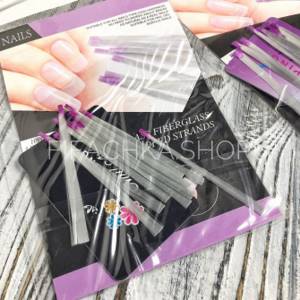
@fifachka.shop
So, now you know what you need for nail extensions, and you can do a beautiful manicure yourself. The main thing is to believe in yourself and work on your mistakes. You will definitely succeed!
Where can I buy
Purchasing a set is profitable because, on average, its price is 25% less than the cost of consumables and tools separately. Beginners can choose kits in retail stores or online. Very cheap goods, for example, are presented on the Aliexpress website, however, sometimes you have to wait a long time for orders. Professional craftsmen are advised to pay attention to the products offered in specialized nail industry stores. As a rule, high quality kits from well-known manufacturers are presented there.
Extension on upper forms: tools and materials
For nail extensions on the upper forms, the tools and materials are similar to the two previous points. Gel polish is most often used as the main material.
The difference between the basic kit is that for such extensions you will need upper forms. It is best for beginners to choose forms with special markings, this will make nail formation much easier.
The forms themselves need to be selected a little less than the nail plates themselves. Since the forms are reusable, you shouldn’t buy a lot of them and “in reserve.” It is enough to have 2-3 sets if you are afraid that some templates may get lost or damaged.
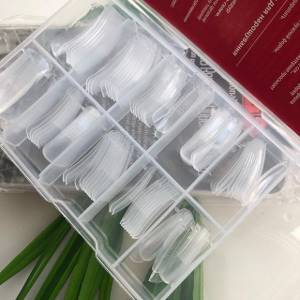
@nails_shop_insta
How much does the kit cost?
The price of the kit depends on many parameters. The cost of the kit is influenced by the number of materials and tools included in the composition, the presence of accessories for decoration, and the brand. Approximate prices for popular sets:
| Name and manufacturer | Equipment | Cost in rubles |
| NOGTIKA, Acrylic extension kit |
| 1590 |
| Runail, Gel nail extension kit |
| 2210 |
| NOGTIKA, Set for gel extensions |
| 1790 |
| EzFlow, Competition Powders Proline Acrilyc Kit, Professional kit for modeling acrylic nails | Contains all necessary consumables and tools. Designed for 35 full procedures. Includes:
| 9360 |
| Irisk Professional, Set for gel nail modeling |
| 1410 |
| EzFlow, Get It! Cover Gels Professional Kit | Set for 55 full extensions, containing:
| 8030 |
| Patrisa Nail, Starter set No. 1 “Gel nail extensions” | Suitable for working at home. Compound:
| 2575 |
| .Ibd., Traditional UV Gel Student Kit, Student kit for modeling gel nails |
| 5090 |
| InGarden, Starter kit for acrylic + gel extensions | Contains materials for 25-30 procedures. Set contents:
| 10660 |
| Irisk Professional, Acrylic nail extension kit |
| 1220 |



